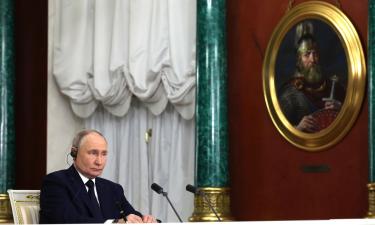Tsunami befalls Solomon Islands,13 killed
Thousands of survivors huddled on a hilltop refuge after a deadly tsunami struck the Solomon Islands on Monday.

The surging waters that plowed through Gizo and surrounding villages on Monday morning were triggered by a massive sub-sea earthquake that set off tsunami alarms from Tokyo to Hawaii and that closed beaches more than 2,000 kilometers (1,250 miles) away.
Thirteen people died, and the toll was expected to rise, officials said.
In Australia, beaches along the entire eastern coast were closed and lifeguards with bullhorns yelled at surfers to get out of the water at Sydney's famous Bondi Beach.
The danger passed quickly, but officials rejected suggestions that they overreacted, saying it was better to be safe than sorry and that the emergency tested procedures put in place after the 2004 Indian Ocean disaster that left 230,000 dead or missing in a dozen countries.
In the Solomons, up to 4,000 people were encamped Monday night on a hill behind Gizo, a town of about 7,000, said Alex Lokopio, premier of Western Province that was hardest hit.
Floodwaters had subsided, but most government buildings and many houses were wrecked, and people were too scared to return to the coast.
"There wasn't any warning _ the warning was the earth tremors," Lokopio told New Zealand's National Radio. "It shook us very, very strongly and we were frightened, and all of a sudden the sea was rising up."
Within five minutes, a wall of water up to five meters (16 feet) high plowed into the coast, inundating homes, businesses, a hospital, schools and two police stations, and dumping boats into streets in Gizo, witnesses and officials said.
Outlying villages, where many houses are flimsy wooden structures, may have fared worse, based on scattered reports from residents with two-way radios.
Villagers on Simbo, Choiseul and Ranunga islands reported deaths and widespread destruction, said Alfred Maesulia, the information director in Prime Minister Manasseh Sogavare's office.
"There are reports that some villages were completely washed away," he told The Associated Press.
"Sasamungga village is quite a big village. ... It was reported that 300 houses were completely destroyed in that village alone."
The Solomon Islands Red Cross reported that around 10 percent of the population in Gizo may have been left homeless, with initial reports from other islands suggesting similar or worse levels of damage.
Phone and electricity lines were heavily damaged, and roads were inaccessible, it said.
Sogavare declared a national state of emergency and held meetings with his impoverished country's aid donors about getting help.
"My heart goes out to all of you at this very trying time," Sogavare said in an address to the nation.
The Australian government pledged 2 million Australian dollars (US$1.6 million; euro1.2 million) in emergency aid and saidhelicopters already in the Solomons as part of a multinational security mission had been made available for rescue and relief.
Helicopters made the first drops of tents, drinking water and other supplies late Monday to the crowd on the hill behind Gizo, said Peter Marshall, the Solomons' deputy police commissioner. Flights were expected to resume Tuesday.
A government damage assessment team flew over the tsunami zone late Monday then reported back to the government in Honiara, the capital, National Disaster Management Office spokesman Julian Makaa said.
One boat carrying relief supplies left Honiara late Monday for Gizo, and at least three more were expected to go on Tuesday, Makaa told the British Broadcasting Corp.
Maesulia said the death toll was expected to rise as the cleanup progressed.
"Some people were seen floating on the sea during the big waves but it was very difficult to go near them," Maesulia told AP. "The number at the moment is 13. It's possible that number will increase, maybe double up or even more."
Numerous aftershocks around magnitude 6 rattled the islands all Monday and into the night.
The original bone-rattling quake struck shortly after 7:39 a.m. (2039 GMT Sunday) just 10 kilometers (6 miles) beneath the sea floor about 40 kilometers (25 miles) from Gizo, the U.S. Geological Survey said.
"It was just a noise like an underground explosion," said resident Dorothy Parkinson. "The wave came almost instantaneously. Everything that was standing is flattened," she told Australia's Nine Network television.
Another resident, Judith Kennedy, said water "right up to your head" swept through the town. Her father, dive shop owner Danny Kennedy, said the surge left the town devastated when it subsided.
"There are boats in the middle of the road, buildings have completely collapsed and fallen down," he told AP.
The Hawaii-based Pacific Tsunami Warning Center initially issued warning bulletins for the Solomon Islands and neighboring Papua New Guinea, and lower-level alerts for most other South Pacific countries, eastern Australia and Hawaii.
The warnings outside the Solomons' zone were lifted within hours, but Australian officials closed beaches, stopped ferry services in Sydney, closed some schools and warned fishing boats to return to port.
"We just feel it's best to err on the side of caution," said Warren Young, the chief lifeguard on the Gold Coast, about 2,200 kilometers (1,370 miles) from the quake's epicenter. Other officials made similar remarks.
All canceled services in Australia had resumed by late Monday.
The Solomon Islands is a poverty-wracked archipelago of more than 200 islands with a population of about 552,000 people that lies on the Pacific Basin's so-called "Ring of Fire," an arc of volcanos and fault lines where quakes frequently happen.
Subscribe to Pravda.Ru Telegram channel, Facebook, RSS!





